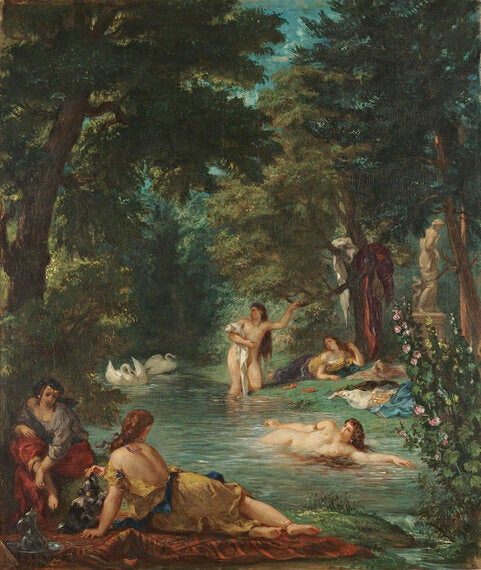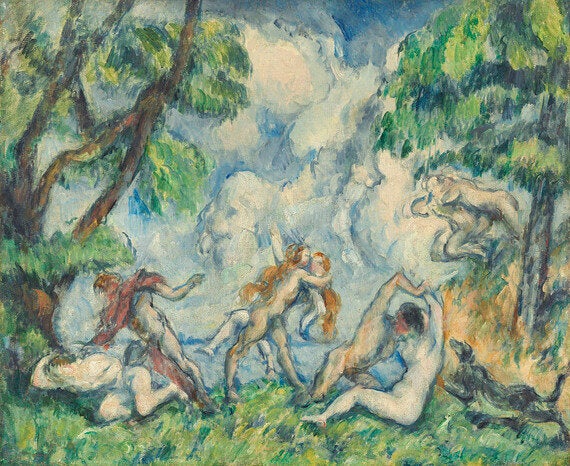
The National Gallery's latest exhibition is on Eugene Delacroix, the 19th century French artist widely considered the leader of the French Romantic school. This is the first major presentation of Delacroix's art in Britain for more than 50 years. Only this isn't a solo artist show. Instead this exhibition proposes to examine Delacroix's influence on those who followed him, including the Impressionists, and Post-Impressionists, such as Cezanne, Van Gogh and Gauguin.
And that influence, the exhibition suggests, is in both subject matter and artistic style.
Delacroix's works were controversial at the time. Their hurried, unfinished look horrified the critics but inspired many of those new artists coming through who were drawn to this rapid, unconventional style.
There's also looseness in his composition. There's much that's Rubens-esque in the ferocity of Lion Hunt, 1861, and in the dense composition of The Death of Sardanapalus, of a royal court in disarray as the order is given for all to be sacrificed to prevent capture by the enemy.
But there's a surprising informality to paintings such as A Moroccan Mounting his Horse, 1854, and The Women of Algiers in their Apartment, 1847-9. It's an interesting departure. And sometimes this works, and sometimes it doesn't.

There are more than a few examples where these more informal paintings lack energy and interest - figures loitering without much intent, with little to make them engaging. It's easy to walk past exhibits such as View of Tangier with Figures, 1853, and Ovid in Exile among the Scythians, 1859, as there is nothing in these to grab you.
And this is where the challenge in this exhibition begins because, well, not to put too fine a point on it - though this is a show principally about Delacroix, the best works on display are those from other artists.
Half the exhibition comprises works by artists of later generations who, it is suggested, were inspired by Delacroix - artists such as Sargent, Renoir, Degas, Gauguin, Cezanne and Matisse. And when works from these artists are hung alongside Delacroix, well, it's Delacroix who seems to come off worse. And it's also questionable how much of what and how the later generation painted can be traced back to just one man.
Delacroix was part of the Romanticism movement and his pictures do have that idealised, highly romanticised style to them, which to be honest is not a style that appeals to me. Pictures of beautiful nymphs bathing cannot impress in the way that Cezanne's The Battle of Love, 1880, and his disarming Standing Nude, 1898, do.

And with regards to subject matter, Renoir's North African travels may have been inspired by Delacroix's trips to Morocco, but can we say the same when talking about Gauguin and his travels? Cezanne was respectively effusive in his praise when he said 'We all paint in Delacroix's language' but artists have many influences, feeding off multiple ideas from many sources. And they also have ideas of their own.
But that's not to say that those Delacroix works included in the exhibition are all to be overlooked. His Self-Portrait, 1837, is glorious in its expression and colour, and his portrait of Louis-Auguste Schwiter, 1826, is impressive. But by and large, this is a show where the supporting acts come out on top.
There are a couple of Van Goghs on show and they are beautiful. His Olive Trees, 1889, that he painted while he was staying at an asylum has his distinctive brushwork and beautiful bold colours, as does his Pieta, 1889, inspired by Delacroix's Christ on the Cross, 1853.
And also included is Kandinsky's Study for Improvisation V, 1910, and his thick brush strokes, the electric blues and bright reds, the blurred forms... This is such a radical reworking of such familiar religious subject matter and it excites, and it intrigues.

So overall, this is an interesting exhibition but when the best pieces of work are from Van Gogh and Kandinsky, and it's supposed to be an exhibition about Delacroix, well, something's gone a little astray somewhere.
National Gallery, London to May 22, 2016
Admission: £16 (concessions available)
Image Credits:
1.Eugène Delacroix, Self Portrait, about 1837, Oil on canvas 65 x 54.5 cm, Musée du Louvre, Paris (RF 25) © RMN-Grand Palais (musée du Louvre) / Jean-Gilles Berizzi
2.Eugène Delacroix Bathers, 1854 Oil on canvas 92.7 x 77.5 cm © Wadsworth Atheneum Museum of Art, Hartford, Connecticut. The Ella Gallup Sumner and Mary Catlin Sumner Collection Fund, 1952.300
3.Paul Cézanne The Battle of Love, about 1880 Oil on canvas 38.1 x 45.7 cm National Gallery of Art, Washington, DC. Gift of the W. Averell Harriman Foundation in memory of Marie N. Harriman, 1972.9.2. Image courtesy of the Board of Trustees, National Gallery of Art, Washington, DC.
4.Vincent van Gogh, Pietà (after Delacroix), 1889 Oil on canvas, 73 x 60.5 cm © Van Gogh Museum (Vincent Van Gogh Foundation), Amsterdam (s168V/1962)